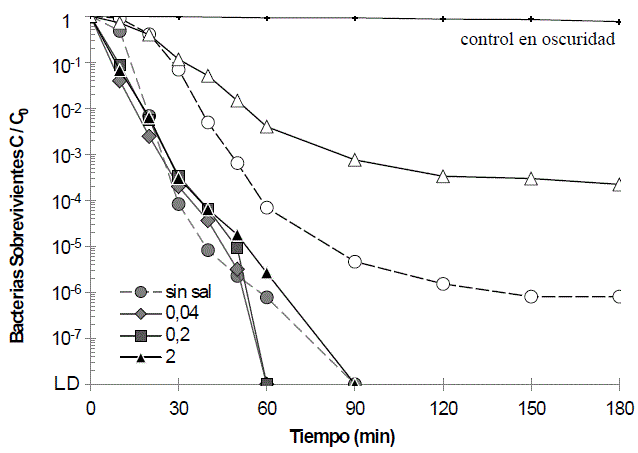Effect of the presence of inorganic salts on the photocatalytic inactivation of E. Coli in water
Main Article Content
Keywords
photocatalysis, TiO2, disinfection, inorganic salts, kinetic.
Abstract
This article presents the effect of inorganic salts MgSO4, NaCl and CaCO3 on the photocatalytic water disinfection. TiO2-P25 was used as a photocatalyst, and E. Coli was used as a contaminant. Disinfection tests were performed by controlling lighting of batch reactors loaded with contaminated water, salts and TiO2. The results of these tests were used to determine the kinetic parameters of a type Langmuir-Hinshelwood model. It was found that the salts have a strong influence on the photocatalytic inactivation of E. Coli and that each salt and its concentration affect disinfection differently in the following order: NaCl>CaCO3>>MgSO4. Additionally, the value of the calculated parameters was different for each salt, showing that the salts affect the process by several mechanisms related to the ion-bacteria interactions, ion-oxidizing species and ion-TiO2.
PACS: 82.65..+r, 61.82.Fk, 82.50.-m
MSC: 65c20, 34-99
Downloads
References
[2] V. A. Nadtochenko, A. G. Rincon, S. E. Stanca, and J. Kiwi, “Dynamics of E-coli membrane cell peroxidation during TiO2 photocatalysis studied by ATR-FTIR spectroscopy and AFM microscopy,” Journal of Photochemistry and Photobiology A-Chemistry, vol. 169, no. 2, pp. 131–137, 2005.
[3] X. Yang and Y. Wang, “Photocatalytic effect on plasmid DNA damage under different UV irradiation time,” Building and Environment, vol. 43, no. 3, pp. 253–257, 2008. [Online]. Available: http://www.sciencedirect.com/science/article/pii/S0360132306003532
[4] J. Lonnen, S. Kilvington, S. C. Kehoe, F. Al-Touati, and K. G. McGuigan, “Solar and photocatalytic disinfection of protozoan, fungal and bacterial microbes in drinking water,” Water Research, vol. 39, no. 5, pp. 877–883, 2005. [Online]. Available: http://www.sciencedirect.com/science/article/pii/S0043135404005640
[5] A. Fujishima, X. Zhang, and D. A. Tryk, “TiO2 photocatalysis and related surface phenomena,” Surface Science Reports, vol. 63, no. 12, pp. 515–582, 2008. [Online]. Available: http://www.sciencedirect.com/science/article/pii/S0167572908000757
[6] M. Cho, H. Chung, W. Choi, and J. Yoon, “Linear correlation between inactivation of E. coli and OH radical concentration in TiO2 photocatalytic disinfection,” Water Research, vol. 38, no. 4, pp. 1069–1077, 2004. [Online]. Available: http://www.sciencedirect.com/science/article/pii/S004313540300602X
[7] A. G. Rincón and C. Pulgarin, “Photocatalytical inactivation of E. coli: effect of (continuous intermittent) light intensity and of (suspended-fixed) TiO2 concentration,” Applied Catalysis B: Environmental, vol. 44, no. 3, pp. 263–284, 2003. [Online]. Available: http://www.sciencedirect.com/science/article/pii/S0926337303000766
[8] C. Sichel, J. Tello, M. de Cara, and P. Fernández-Ibáñez, “Effect of UV solar intensity and dose on the photocatalytic disinfection of bacteria and fungi,” Catalysis Today, vol. 129, no. 1–2, pp. 152–160, 2007. [Online]. Available: http://www.sciencedirect.com/science/article/pii/S092058610700421X
[9] H. M. Coleman, C. P. Marquis, J. A. Scott, S.-S. Chin, and R. Amal, “Bactericidal effects of titanium dioxide-based photocatalysts,” Chemical Engineering Journal, vol. 113, no. 1, pp. 55–63, 2005. [Online]. Available: http://www.sciencedirect.com/science/article/pii/S1385894705002494
[10] M. Gourmelon, J. Cillard, and M. Pommepuy, “Visible light damage to Escherichia coli in seawater: oxidative stress hypothesis,” J Appl Bacteriol, vol. 77, no. 1, pp. 105–112, 1994. 195
[11] A. G. Rincon and C. Pulgarin, “Effect of pH, inorganic ions, organic matter and H2O2 on E-coli K12 photocatalytic inactivation by TiO2 - Implications in solar water disinfection,” Applied Catalysis B: Environmental, vol. 51, no. 4, pp. 283–302, 2004.
[12] C. Castro, C. Romero, O. Salazar, A. Centeno, and S. Giraldo, “Efecto de la Composición Química del Agua Sobre su Desinfección Fotocatalítica,” Act. y Div. Cient., vol. 14, no. 1, pp. 117–125, 2011.
[13] J. Marugán, R. van Grieken, C. Sordo, and C. Cruz, “Kinetics of the photocatalytic disinfection of Escherichia coli suspensions,” Applied Catalysis B: Environmental, vol. 82, no. 1–2, pp. 27–36, 2008. [Online]. Available: http://www.sciencedirect.com/science/article/pii/S0926337308000052
[14] A. Moreno, C. Castro, A. Centeno, and S. Giraldo, “Cinética de la Desinfección Fotocatalítica de Agua contaminada con E. coli: Efecto de la Concentración del Fotocatalizador y la Potencia de Irradiación,” Inf. tecnol., vol. 22, no. 3, pp. 69–78, 2011.
[15] O. K. Dalrymple, E. Stefanakos, M. A. Trotz, and D. Y. Goswami, “A review of the mechanisms and modeling of photocatalytic disinfection,” Applied Catalysis B: Environmental, vol. 98, no. 1–2, pp. 27–38, 2010. [Online]. Available: http://www.sciencedirect.com/science/article/pii/S0926337310001918
[16] M. Labas, C. Martin, and A. Cassano, “Kinetics of Bacteria Disinfection with UV Radiation in an Absorbing and Nutritious Medium,” Chemical Engineering Journal, vol. 114, no. 1-3, pp. 87–97, 2005.
[17] K. V. Kumar, K. Porkodi, and F. Rocha, “Langmuir-Hinshelwood kinetics: A theoretical study,” Catalysis Communications, vol. 9, no. 1, pp. 82–84, 2008. [Online]. Available: http://www.sciencedirect.com/science/article/pii/S1566736707002178
[18] G. Gogniat and S. Dukan, “TiO2 photocatalysis causes DNA damage via Fenton reaction-generated hydroxyl radicals during the recovery period.” Appl Environ Microbiol, vol. 73, no. 23, pp. 77–40–7743, 2007.
[19] M. Abdullah, G. K. C. Low, and R. W. Matthews, “Effects of common inorganic anions on rates of photocatalytic oxidation of organic carbon over illuminated titanium dioxide,” J. Phys. Chem., vol. 94, no. 17, pp. 6820–6825, 1990. [Online]. Available: http://pubs.acs.org/doi/abs/10.1021/j100380a051
[20] R. van Grieken, J. Marugán, C. Pablos, L. Furones, and A. López, “Comparison between the photocatalytic inactivation of Gram-positive E. faecalis and Gramnegative E. coli faecal contamination indicator microorganisms,” Applied Catalysis B: Environmental, vol. 100, no. 1–2, pp. 212–220, 2010. [Online]. Available: http://www.sciencedirect.com/cience/article/pii/S0926337310003401
[21] M. N. Chong, B. Jin, H. Zhu, and C. Saint, “Bacterial inactivation kinetics, regrowth and synergistic competition in a photocatalytic disinfection system using anatase titanate nanofiber catalyst,” Journal of Photochemistry and Photobiology A: Chemistry, vol. 214, no. 1, pp. 1–9, 2010. [Online]. Available: http://www.sciencedirect.com/science/article/pii/S1010603010001826
[22] A. G. Rincón, C. Pulgarin, N. Adler, and P. Peringer, “Interaction between E. coli inactivation and DBP-precursors-dihydroxybenzene isomers in the photocatalytic process of drinking-water disinfection with TiO2,” Journal of Photochemistry and Photobiology A: Chemistry, vol. 139, no. 2–3, pp. 233–241, 2001. [Online]. Available: http://www.sciencedirect.com/science/article/pii/S1010603001003744
[23] J. J. Vélez-Colmenares, A. Acevedo, and E. Nebot, “Effect of recirculation and initial concentration of microorganisms on the disinfection kinetics of Escherichia coli,” Desalination, vol. 280, no. 1–3, pp. 20–26, 2011. [Online]. Available: http://www.sciencedirect.com/science/article/pii/S0011916411005698

